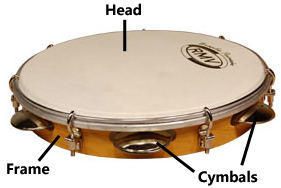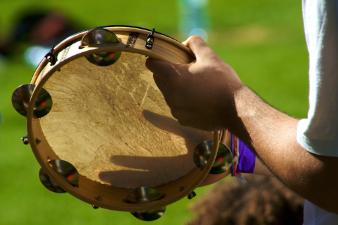|
Capoeira Instruments - Pandeiro By being used all over Brazil, that’s how! This little drum is a key instrument in the world of Brazilian music. It is also very important within Capoeira. It’s the next instrument in line after the berimbau. Here it faithfully keeps the beat of the game. Read and learn how this little drum lives up to it’s title… Significance in Brazilian Culture
I remember looking at the pandeiro and thinking nothing of it. To me, it looked too simple to be that important. I was wrong, very wrong. This capoeira instruments potential is only limited by the person playing it. Its diverse sounds, rhythms and beats are use everywhere in Brazilian music and culture. It’s essential in samba and played throughout Mardi Gras. It is also very essential as one of the key capoeira instruments. In capoeira music, the pandeiro is the second instrument to start playing after the berimbau. It provides the beat and base for the music. You can see this importance in traditional capoeira regional games. In this style, the berimbau is accompanied by two pandeiros. I know, just from looking at it, it’s hard to see how important it is. The simple design can hide its musical depth. Parts to the Pandeiro
At first glance it’s easy to mistake the pandeiro for a simple tambourine. On a closer look however, its parts tell a different story. There are a few key parts to this hand drum that make it what it is. 
These simple parts come together to create one of the capoeira instruments that has a lot of musical potential. To make use of this potential, you first have to learn the basics in playing it. How to Play
There’s a lot of variety that can come from playing this simple little drum. The secret is knowing what you can do with it. From there, you have the freedom of doing whatever you can imagine. The first step though is holding the pandeiro… You can’t play it if you can’t hold it!
Now that you’re holding it, you can try its different notes
Basic Rhythms
With the variety sounds that this drum can make, there are an unlimited number of rhythms that can be played. However like other capoeira instruments, there are some basic rhythms that are played in the roda that you can learn and use right away. These basic rhythms below are the first I learned to play in capoeira:
Start with these and experiment with more. In time you'll learn to do amazing things with this and other capoeira instruments! Where to Buy
Virtual Capoeira sells a couple varieties of pandeiros. Check them out here! Return from Pandeiro to Capoeira Instruments
|



 How does one of the simple capoeira instruments like the pandeiro get a big title like "The Instrument of Brazil"?
How does one of the simple capoeira instruments like the pandeiro get a big title like "The Instrument of Brazil"?